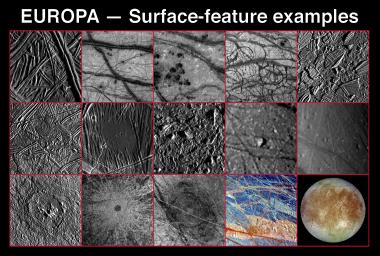These 15 frames show the great variety of surface features on Jupiter's icy moon, Europa, which have been revealed by the Galileo spacecraft Solid State Imaging (CCD) system during its first six orbits around Jupiter from June 1996 to February 1997. North is to the top of each of the images. The features seen on Europa's surface document both internal and external processes shaping the icy crust. Internal processes and the possible presence of liquid water beneath the ice are indicated by features such as "dark spots," lobe-shaped flow features, "puddles,""mottled terrain," knobs, pits, and the darker areas along ridges and triple bands.
Europa is subjected to constant tugging from the giant planet, Jupiter, as well as from its neighboring moons, Io and Ganymede. This causes "tidal" forces that affect Europa's interior and surface. Evidence for such forces includes ridges, fractures, wedge-shaped bands, and areas of "chaos." Some of these features result from alternate extension and compression buckling and pulling apart Europa's icy shell.
Impact craters document external effects on a planet's surface. Although present on Europa, impact craters are relatively scarce compared to the number seen on Ganymede, Callisto, and on the surfaces of most other "rocky" planets and moons in our solar system. This scarcity of craters suggests that the surface of Europa is very young. "Maculae" on Europa may be the scars from large impact events.
These images have resolutions from 27 meters (89 feet) to 7 kilometers (4.3 miles) per picture element (pixel) and were taken by Galileo at ranges of 2,500 kilometers (1,525 miles) to 677,000 kilometers (413,000 miles) from Europa.
The Jet Propulsion Laboratory, Pasadena, CA manages the Galileo mission for NASA's Office of Space Science, Washington, DC. JPL is an operating division of California Institute of Technology (Caltech).
This image and other images and data received from Galileo are posted on the World Wide Web, on the Galileo mission home page at URL http://galileo.jpl.nasa.gov. Background information and educational context for the images can be found at http://www.jpl.nasa.gov/galileo/sepo.

 Planetary Data System
Planetary Data System












